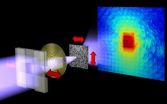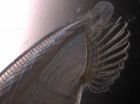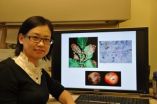Fish oil may protect dialysis patients from sudden cardiac death
2013-02-07
(Press-News.org) INDIANAPOLIS -- Medical literature long has touted the benefits of omega-3 fatty acids for the heart. But until now, researchers have not studied the potential benefit for people on hemodialysis, who are among the highest-risk patients for sudden cardiac death.
A study published Feb. 6 online in the journal Kidney International, which included 100 patients who died of sudden cardiac death during their first year of hemodialysis and 300 patients who survived, is the first to examine this question.
Allon N. Friedman, M.D., associate professor of medicine in the Division of Nephrology at the Indiana University School of Medicine and first author of the study, said the findings are impressive enough that he believes a placebo-controlled clinical study is warranted to confirm the results.
"We found that higher levels of omega-3 fatty acids in the blood of patients who were just starting hemodialysis were very strongly associated with a lower risk of sudden cardiac death over the first year of their treatment," Friedman said.
The five-year survival rate for patients on hemodialysis is 35 percent, with the risk of death highest in the first few months of starting treatment. The most common cause of death in these patients is sudden cardiac death, which accounts for about one out of every four deaths.
"The risk of sudden cardiac death in hemodialysis patients is highest during the first year of treatment. The annual rate of sudden cardiac death is about 6 to 7 percent, which may even exceed the rate in patients with heart failure," Friedman said. "This study is a first step toward identifying a possible treatment for sudden cardiac death in dialysis patients.
"Because omega-3 fatty acids can be obtained from certain foods, such as fish oil, our findings also have important implications for the type of diet we recommend to patients on dialysis," Friedman said.
Others involved in the research are Zhangsheng Yu, Rebeka Tabbey and Cheryl Denski from the Indiana University Department of Biostatistics; Hector Tamez, Julia Wenger and Ravi Thadhani from the Division of Nephrology at Massachusetts General Hospital; and Yong Li and Bruce A. Watkins with the Department of Nutritional Sciences, Lipid Chemistry and Molecular Biology Laboratory at the University of Connecticut.
INFORMATION:
Funding for this research was provided by the National Institutes of Health and the National Kidney Foundation.
END
ELSE PRESS RELEASES FROM THIS DATE:
2013-02-07
SAN FRANCISCO, Feb. 6, 2013 -- Nitrogen in ocean waters fuels the growth of two tiny but toxic phytoplankton species that are harmful to marine life and human health, warns a new study published in the Journal of Phycology.
Researchers from San Francisco State University found that nitrogen entering the ocean -- whether through natural processes or pollution -- boosts the growth and toxicity of a group of phytoplankton that can cause the human illness Amnesic Shellfish Poisoning.
Commonly found in marine waters off the North American West Coast, these diatoms (phytoplankton ...
2013-02-07
Since the observations made by English naturalist Charles Darwin on the Galapagos Islands, researchers have been interested in how physical barriers, such as isolation on a particular island, can lead to the formation of new species through the process of natural selection. Natural selection is a process whereby heritable traits that enhance survival become more common in successive generations, while unfavorable heritable traits become less common. Over time, animals and plants that have morphologies or other attributes that enhance their suitability to a particular environment ...
2013-02-07
ANN ARBOR—Hunger, thirst, stress and drugs can create a change in the brain that transforms a repulsive feeling into a strong positive "wanting," a new University of Michigan study indicates.
The research used salt appetite to show how powerful natural mechanisms of brain desires can instantly transform a cue that always predicted a repulsive Dead Sea Salt solution into an eagerly wanted beacon or motivational magnet.
Mike Robinson, a research fellow in the U-M Department of Psychology and the study's lead author, said the findings help explain how related brain activations ...
2013-02-07
AUDIO:
In the 1970s and early 1980s, some states lower their minimum legal drinking age below the age of 21. Those lower drinking ages have been linked to bad things, from...
Click here for more information.
People who grew up in states where it was legal to drink alcohol before age 21 are more likely to be binge drinkers later in life, according to a study by researchers at Washington University School of Medicine in St. Louis.
The findings are available online in Alcoholism: ...
2013-02-07
For more than 100 years radiography meant: don't move! In order to visualize nanostructures such as biological cells, the porous structure of cement or storage fields of magnetic disks, the experimentators had to avoid any kind of vibration of X-ray microscope and sample. In addition, only a small percentage fraction of the incoming X-ray radiation could be used. Using special filters, they had to select exactly the fraction with the right properties – for example, the right wavelength.
Contributions of different wavelengths separated
Pierre Thibault of the Technische ...
2013-02-07
CHICAGO -- Feeding human breast milk to very-low-birth-weight infants greatly reduces risk for sepsis and significantly lowers associated neonatal intensive care unit (NICU) costs, according to a study by Rush University Medical Center researchers.
The study, published Jan. 31 in the advance online version of the Journal of Perinatology, showed that every 10 milliliters of human milk per kilogram that a very low birth weight infant received during the first 28 days of life decreased the odds of sepsis by almost 20 percent.
A daily dose of 25 to 49.99 milliliters of ...
2013-02-07
WOODS HOLE, MASS. -- Among the animals that are appealing "cover models" for scientific journals, lancelets don't spring readily to mind. Slender, limbless, primitive blobs that look pretty much the same end to end, lancelets "are extremely boring. I wouldn't recommend them for a home aquarium," says Enrico Nasi, adjunct senior scientist at the Marine Biological Laboratory (MBL). Yet Nasi and his collaborators managed to land a lancelet on the cover of the Journal of Neuroscience last December. These simple chordates, they discovered, offer insight into our own biological ...
2013-02-07
RIVERSIDE, Calif. — When a pathogen attacks a plant, infection usually follows after the plant's immune system is compromised. A team of researchers at the University of California, Riverside focused on Phytophthora, the pathogen that triggered the Irish Famine of the 19th century by infecting potato plants, and deciphered how it succeeded in crippling the plant's immune system.
The genus Phytophthora contains many notorious pathogens of crops. Phytophthora pathogens cause worldwide losses of more than $6 billion each year on potato (Phytophthora infestans) and about ...
2013-02-07
SALT LAKE CITY, Feb. 7, 2013 – A University of Utah seismologist analyzed seismic waves that bombarded Earth's core, and believes he got a look at the earliest roots of Earth's most cataclysmic kind of volcanic eruption. But don't worry. He says it won't happen for perhaps 200 million years.
"What we may be detecting is the start of one of these large eruptive events that – if it ever happens – could cause very massive destruction on Earth," says seismologist Michael Thorne, the study's principal author and an assistant professor of geology and geophysics at the University ...
2013-02-07
Cancer drugs of the new, molecular generation destroy malignant breast tumors in a targeted manner: They block characteristic molecules on tumor cells - receptors for the hormones estrogen or progesterone, or a co-receptor, called HER2, that binds to many growth factors. But about one in every six breast tumors has none of these receptors. Such cancers, called triple-negative, are particularly aggressive and notoriously difficult to treat.
Some of these therapy-resistant cancers have a potential molecular target for cancer drugs, a growth-factor receptor called EGFR, ...
LAST 30 PRESS RELEASES:
[Press-News.org] Fish oil may protect dialysis patients from sudden cardiac death





